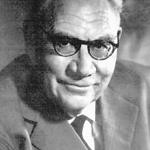Person
Jaeger, John Conrad (1907 - 1979)
FAA FRS

John Conrad Jaeger
Details
- Born
- 30 July 1907
Sydney, New South Wales, Australia - Died
- 15 May 1979
Canberra, Australian Capital Territory, Australia - Occupation
- Geophysicist and Mathematician
Summary
John Jaeger was Professor of Geophysics at the Australian National University 1951-1972. He had previously been Lecturer in Mathematics and subsequently Professor of Applied Mathematics at the University of Tasmania 1935-1951. He achieved fame as an applied mathematician, especially through his books and his teaching; Conduction of Heat in Solids alone would have ensured continuing international recognition. Then he became one of the major moving forces in solid-earth geophysics and geochemistry in Australia, founding a school of high international standing and making important contributions in geothermal studies and rock mechanics. Since 1980 the Australian Geomechanics Society has awarded the John Jaeger Memorial Award that recognises contributions of the highest order over a lifetime commitment to the geotechnical profession in Australia. Since 1990 the Australian Academy of Science has awarded the Jaeger Medal for investigations of a high order into the solid Earth or its oceans.
Details
Chronology
- 1928
- Education - Bachelor of Science (BSc), University of Sydney
- 1930
- Education - Bachelor of Arts (BA), University of Cambridge
- 1931 - 1935
- Career position - Research Scholar, Trinity College, University of Cambridge
- 1934
- Education - Master of Arts (MA), University of Cambridge
- 1936 - 1944
- Career position - Lecturer in Mathematics, University of Tasmania
- 1941
- Education - Doctor of Science (DSc), University of Sydney
- 1942 - 1945
- Career position - Physicist, Radiophysics Laboratory, CSIRO Division of Radiophysics
- 1944 - 1948
- Career position - Senior Lecturer in Mathematics, University of Tasmania
- 1947
- Award - Walter Burfitt Prize, Royal Society of New South Wales
- 1947
- Award - Thomas Ranken Lyle Medal, Australian National Research Council
- 1949 - 1950
- Career position - Associate Professor, University of Tasmania
- 1950 - 1951
- Career position - Professor of Applied Mathematics, University of Tasmania
- 1951 - 1972
- Career position - Foundation Professor of Geophysics, Australian National University
- 1954
- Award - Foundation Fellow, Australian Academy of Science (FAA)
- 1969
- Award - Rock Mechanics Award (with N. G. W. Cook), American Institute of Mining, Metallurgical and Petroleum Engineers
- 1970
- Award - Fellow, The Royal Society, London (FRS)
- 1972 - 1979
- Career position - Emeritus Professor, Australian National University
- 1975
- Award - Doctor of Science (DSc), honoris causa, University of Tasmania
Related entries
Archival resources
Adolph Basser Library, Australian Academy of Science
Published resources
Encyclopedia of Australian Science and Innovation Exhibitions
- Exhibition Papers, A Bright Sparcs Exhibition, Australian Science Archives Project, 1997, http://www.asap.unimelb.edu.au/bsparcs/exhib/papers/exhib_papers.htm. Details
- Smith, Ailie, Adolph Basser Library Manuscript Collection, eScholarship Research Centre, Melbourne, 2012, https://www.eoas.info/exhibitions/basser/basser_browse.html. Details
Book Sections
- Jaeger, J. C., 'Carslaw, Horatio Scott (1870-1954), mathematician' in Australian dictionary of biography, volume 7: 1891 - 1939 A-Ch, Bede Nairn and Geoffrey Serle, eds (Melbourne: Melbourne University Press, 1979), pp. 578-579. http://www.adb.online.anu.edu.au/biogs/A070583b.htm. Details
- Paterson, M.S., 'Jaegar, John Conrad (1907-1979), Mathematical Physicist' in Australian dictionary of biography, volume 14: 1940 - 1980 Di-Kel, John Ritchie, ed. (Melbourne: Melbourne University Press, 1996), pp. 551-552. http://www.adb.online.anu.edu.au/biogs/A140625b.htm. Details
Journal Articles
- Jaeger, J. C., 'Horatio Scott Carslaw', Australian Mathematics Teacher, 11 (1955), 59-66. Details
- Jaeger, J. C., 'Horatio Scott Carslaw', Journal of the London Mathematical Society, S1-31 (4) (1956), 494-501, https://londmathsoc.onlinelibrary.wiley.com/doi/epdf/10.1112/jlms/s1-31.4.494. Details
- Lilley, F. E. M., 'Demonstrating that Continents Had Drifted: Paleomagnetic Measurements at the Australian National University 1952-1964', Historical Records of Australian Science, 23 (1) (2012), 1-33, https://doi.org/10.1071/HR12003. Details
- Paterson, M. S., 'John Conrad Jaeger, 30 July 1907 - 15 May 1979', Biographical memoirs of Fellows of the Royal Society, 28 (1982), 163-203. https://doi.org/10.1098/rsbm.1982.0009. Details
- Paterson, M. S., 'John Conrad Jaeger 1907-1979', Historical Records of Australian Science, 5 (3) (1982), 64-88. https://doi.org/10.1071/HR9820530064. Details
Resources
- Wikidata, http://www.wikidata.org/entity/Q15451116. Details
- VIAF - Virtual International Authority File, OCLC, https://viaf.org/viaf/108635489. Details
- 'Jaeger, J C (19070730-19790515)', Trove, National Library of Australia, 2009, https://nla.gov.au/nla.party-970818. Details
Resource Sections
- 'Jaeger, John Conrad - Ms 120', in Listing of Adolph Basser Library holdings, Australian Academy of Science, 1994, http://www.science.org.au/basser/manuscript-collection/ms120.html. Details
- 'Jaeger, John Conrad', in Physics in Australia to 1945, R.W. Home, with the assistance of Paula J. Needham, Australian Science Archives Project, June 1995, http://www.asap.unimelb.edu.au/bsparcs/physics/P000519p.htm. Details
- Paterson, M. S., 'John Conrad Jaeger 1907-1979', in Australian Academy of Science Biographical Memoirs, Australian Academy of Science, 1982, https://www.science.org.au/fellowship/fellows/biographical-memoirs/john-conrad-jaeger-1907-1979. Details
See also
- Thomas Ranken Lyle Medal, Australian Academy of Science, Canberra, 2023. https://www.science.org.au/supporting-science/awards-and-opportunities/thomas-ranken-lyle-medal. Details
- Academy of Technological Sciences and Engineering, Technology in Australia 1788-1988, Online edn, Australian Science and Technology Heritage Centre, Melbourne, 3 May 2000, http://www.austehc.unimelb.edu.au/tia/index_j.html. Details
- Mellor, D.P., 'Optical Munitions', Chapter 12 in Australia in the War of 1939-1945, Series 4: Civil, volume 5 'The Role of Science and Industry', Canberra: Australian War Memorial, 1958 (1958). http://www.asap.unimelb.edu.au/bsparcs/exhib/papers/mellor.htm. Details
Digital resources
McCarthy, G.J.
Created: 20 October 1993, Last modified: 23 November 2022
- Foundation Supporter - Committee to Review Australian Studies in Tertiary Education
